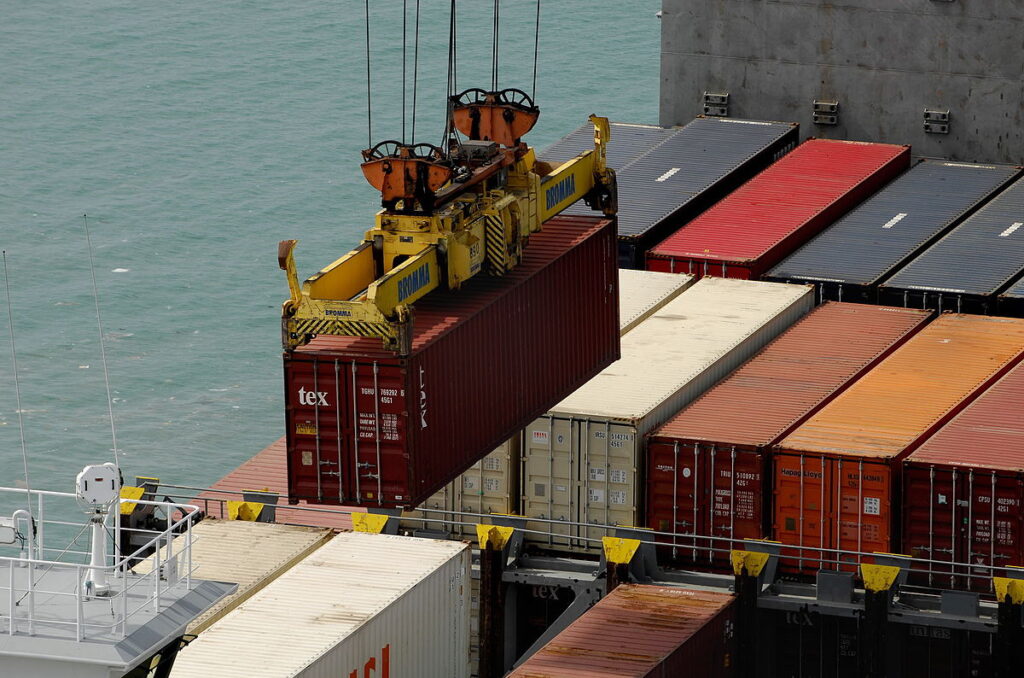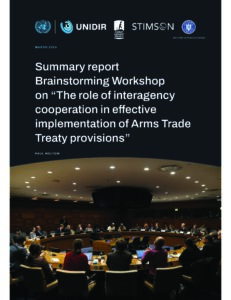Under Article 11 of the Arms Trade Treaty (ATT), States Parties have an obligation to prevent diversion in conventional arms transfers. This report presents findings from the testing of a new voluntary Tool developed to assist interested States Parties in analysing their enabling environment for preventing diversion, covering measures across all stages of the arms transfer chain. Therefore, this report provides an initial assessment of the impact of the ATT on measures taken by a sample of eight ATT States Parties. The report makes two contributions: First, it highlights the impact of the ATT on the implementation of counter-diversion measures across the arms transfer chain, showing an overall significant strengthening of States Parties’ enabling environments. Second, it validates the Counter-Diversion Assessment Tool and demonstrates its usefulness for identifying gaps and effective measures for preventing diversion in a comprehensive manner.
ATT Article 11 requires every State Party involved in the international transfer of conventional arms to take measures to prevent, detect, and address the diversion of conventional arms at every stage in the transfer chain. Previous research has identified a comprehensive list of diversion risk factors14 Alfredo Malaret Baldo, Manuel Martinez Miralles, Erica Mumford and Natalie Briggs, “Arms Trade Treaty Issue Brief 3: Diversion Analysis Framework”, United Nations Institute for Disarmament Research with Conflict Armament Research, Stimson Centre, 2021. The Counter Diversion Assessment Tool developed for this study compiles a list of indicative measures corresponding to these risk factors that have a direct relationship to ATT provisions for the prevention of diversion, encompassing unilateral, bilateral, and multilateral systemic and practical measures. Each set of measures is accompanied by a list of questions facilitating the assessment of the existence and efficacy of an enabling environment for preventing diversion in each State Party using the Tool.
For the purposes of this study, an enabling environment for preventing diversion (counter-diversion enabling environment) is:
a constellation of systemic and practical measures applicable to each State unilaterally (affecting actors and items directly within an ATT State Party’s national jurisdiction), bilaterally (affecting actors and items within two national jurisdictions, at least one of which is an ATT State Party) and multilaterally (affecting actors and items internationally and/or regionally amongst ATT States Parties and non-parties) throughout the arms transfer chain in order to address the risks of diversion.
In the pilot study, the Tool was applied to a quasi-representative sample of eight ATT States Parties anonymised and divided into three groups based on their rankings in the United Nations Development Programme’s (UNDP) Human Development Index. This was done to facilitate comparability and analysis of the findings. Group 1 represents three highly developed countries who are significant manufacturers, exporters and importers of conventional arms. Group 2 represents two countries that are mid-range in terms of their development. One of the countries in Group 2 is a mid-range arms exporter and importer while the other is largely dependent on imported arms. Group 3 represents three less developed countries that are highly dependent on imports for their national holdings of arms and are also significant locations for the transit of arms. The study, via interviews with national authorities from the eight States Parties and desk research, presents findings on the measures taken by the States since the ATT entered into force in December 2014.
Section 3.1 presents findings from the assessment of the eight States Parties’ measures to:
- Strengthen institutional capacities to control arms transfers; and
- Criminalise and detect deceptive methods of diversion.
These measures are applicable to all stages of the arms transfer chain. The ATT’s impact on Group 2 and 3 countries was strongly evidenced by the political and practical impetus gained by these States in implementing effective measures to strengthen their enabling environments. For Group 1 countries, the impact of the ATT, while notable, was generally minimal with regards to the measures assessed here as most of the States had well-established national control systems prior to the ATT’s entry into force. Thus, the notable impact of the Treaty on the Group 1 countries was seen in underscoring existing gaps in their legislative and regulatory frameworks and prompting amendments and measures to further strengthen their enabling environments where necessary.
Section 3.2 presents findings on the measures taken by the States Parties to address diversion risks before transfers by assessing the existence and efficacy of measures applicable to the:
- Manufacture and assembly of conventional arms; and
- Diversion risk assessment of an export.
The study shows that most of the examined States Parties already had in place relevant national legislation regulating actors and entities engaged in the manufacture and assembly of conventional arms prior to the ATT’s entry into force. In terms of measures taken by the States to prevent diversion during export risk assessments, the research revealed that most of the States Parties draw extensively on the guidelines and conventions of other multilateral and regional instruments to which they are a Party thereby showing the complementarity of the ATT with other relevant international and regional instruments in terms of measures applicable before authorising or denying a transfer.
The findings presented in Section 3.3 focus on counter-diversion measures applicable during the transfer. Questions from the Counter-Diversion Assessment Tool assessed measures applicable to:
- Transport and Routes; and
- Unauthorised cross-border movements.
The research for this study found that Group 1 States Parties had appropriate measures applicable to transport and transfer routes prior to the ATT’s entry into force. However, these States Parties noted the ATT’s important role in reinforcing the norms and standards contained in international transportation treaties to implement appropriate measures during a transfer to promote a more secure global arms trade.
In terms of measures to address unauthorised cross-border movements of conventional arms and related items, all the States Parties engaged in the study participated in some form of bilateral or regional arrangements or initiatives that allow joint monitoring, patrols and inspection of borders and border regions, carrying out law enforcement activities, investigating cross-border firearms trafficking offenses and adequate training of law enforcement officials to support diversion prevention efforts. The research showed that States Parties’ participation in such arrangements facilitated the exchange of information relevant to diversion prevention efforts such as the kinds of information recommended in ATT Articles 11 (5) and 15 (4).
Section 3.4 presents evidence of the ATT’s impact on States Parties’ progress in implementing appropriate measures to prevent, detect, mitigate and address diversion at the delivery and post-delivery stage. The research shows that the ATT influenced change in at least one country in all three Groups. At this stage, the study assessed the States Parties’ progress in implementing measures:
- At points of delivery;
- In national stockpiles; and
- For secure management of transferred arms during deployment.
To enhance delivery and post-delivery verification procedures, one country in Group 1 introduced a new measure for carrying out selective post-shipment controls in third countries following the ATT’s entry into force. This measure is now enshrined in the end-user certificates (EUC) of the State Party, further strengthening its EUC requirements. One country in Group 2 also introduced a series of reforms in 2020, to strengthen customs controls to enhance measures at the points of delivery. In Group 3, one country enacted a law in 2019, to enhance efforts to prevent diversion of arms during deployment by criminalizing the illegal misappropriation of arms, ammunition and related materials by members of the armed forces or an insurrectionary movement with punishments ranging from five years in prison if violence or threats are used to life imprisonment for uniformed officers.
Overall, the study documents significant progress made by the States Parties in strengthening their enabling environments to prevent diversion and suggests that the ATT has played a role in facilitating or initiating these changes. The level of progress varied across the different types of measures and the different groupings. This suggests that States in a particular group might have prioritised some measures, perhaps due to similar needs or systems in place before the Treaty came into force. Despite the documented progress made by the States Parties in strengthening their counter-diversion enabling environment, the officials interviewed willingly identified the need to expand and entrench measures in certain areas, highlighting appetite and room for more effective policies and practices under the Treaty moving forward.
Finally, the pilot study validates the practical applicability and utility of the Counter-Diversion Assessment Tool to assess a State’s enabling environment for preventing diversion in a systematic and comprehensive manner. It constitutes a first step in using the Tool. Looking forward, the Consortium encourages all interested ATT States Parties and stakeholders to utilise the Tool in assessing the existence and efficacy of an enabling environment in their national context and share findings in relevant ATT, multilateral and regional meetings pursuant to their national laws to increase knowledge on effective counter-diversion measures and policies. The Consortium also welcomes feedback from stakeholders on the use of the Tool for consideration in any potential future revisions.
The full PDF is published on UNIDIR.
Notes
- 14 Alfredo Malaret Baldo, Manuel Martinez Miralles, Erica Mumford and Natalie Briggs, “Arms Trade Treaty Issue Brief 3: Diversion Analysis Framework”, United Nations Institute for Disarmament Research with Conflict Armament Research, Stimson Centre, 2021




